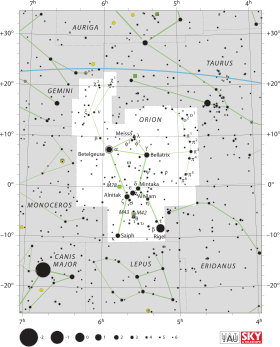Pi2 Orionis (π2 Ori / π2 Orionis) est une étoile blanche de la constellation d'Orion . Elle est répertoriée dans le Bright Star Catalogue binaire spectroscopique [ 11] [ 12] œil nu avec une magnitude apparente de 4,35[ 2] parallaxe annuelle mesurée par le satellite Hipparcos de 14,53 ± 0,38 mas [ 1] a.l. pc
Pi2 Orionis est une étoile blanche de la séquence principale de type spectral A1 V [ 3] raies d'absorption apparaissant élargies en raison de sa rotation rapide. Elle tourne en effet sur elle-même à une vitesse de rotation projetée de 261 km/s [ 5] forme aplatie (oblate ) avec un bourrelet équatorial qu'on estime être 13 % plus grand que son rayon polaire[ 13]
Pi2 Orionis a un âge qui est estimé à 166 millions d'années[ 6] celle du Soleil [ 6] rayon solaire [ 7] lumineuse que le Soleil [ 9] température de surface est de 9 457 K [ 8]
↑ a b c d e et f (en) F. van Leeuwen , « Validation of the new Hipparcos reduction », Astronomy & Astrophysics vol. 474, no 2, novembre 2007 , p. 653–664 (DOI 10.1051/0004-6361:20078357 Bibcode 2007A&A...474..653V arXiv 0708.1752 ↑ a b c et d (en) H. L. Johnson et al. UBVRIJKL photometry of the bright stars », Communications of the Lunar and Planetary Laboratory vol. 4, no 99, 1966 (Bibcode 1966CoLPL...4...99J ↑ a et b (en) A. Cowley et al. A study of the bright A stars. I. A catalogue of spectral classifications », The Astronomical Journal vol. 74, avril 1969 , p. 375–406 (DOI 10.1086/110819 Bibcode 1969AJ.....74..375C ↑ (en) Ralph Elmer Wilson , General Catalogue of Stellar Radial Velocities 1953 (Bibcode 1953GCRV..C......0W ↑ a b et c (en) M. Ammler-von Eiff et A. Reiners , « New measurements of rotation and differential rotation in A-F stars: Are there two populations of differentially rotating stars? », Astronomy & Astrophysics vol. 542, 2012 , A116 (DOI 10.1051/0004-6361/201118724 Bibcode 2012A&A...542A.116A arXiv 1204.2459 ↑ a b c et d (en) Trevor J. David et Lynne A. Hillenbrand , « The Ages of Early-Type Stars: Strömgren Photometric Methods Calibrated, Validated, Tested, and Applied to Hosts and Prospective Hosts of Directly Imaged Exoplanets », The Astrophysical Journal vol. 804, no 2, mai 2015 , p. 146 (DOI 10.1088/0004-637X/804/2/146 Bibcode 2015ApJ...804..146D arXiv 1501.03154 ↑ a et b (en) L. E. Pasinetti Fracassini et al. Catalogue of Apparent Diameters and Absolute Radii of Stars (CADARS) - Third edition - Comments and statistics », Astronomy & Astrophysics vol. 367, no 2, février 2001 , p. 521–524 (DOI 10.1051/0004-6361:20000451 Bibcode 2001A&A...367..521P arXiv astro-ph/0012289 ↑ a b c et d (en) Yue Wu et al. Coudé-feed stellar spectral library - atmospheric parameters », Astronomy & Astrophysics vol. 525, janvier 2011 , A71 (DOI 10.1051/0004-6361/201015014 Bibcode 2011A&A...525A..71W arXiv 1009.1491 ↑ a et b (en) I. McDonald , A. A. Zijlstra et M. L. Boyer , « Fundamental Parameters and Infrared Excesses of Hipparcos Stars », Monthly Notices of the Royal Astronomical Society vol. 427, no 1, 2012 , p. 343–57 (DOI 10.1111/j.1365-2966.2012.21873.x Bibcode 2012MNRAS.427..343M arXiv 1208.2037 ↑ (en) * pi.02 Ori -- Star sur la base de données Simbad Centre de données astronomiques de Strasbourg .↑ (en) Dorrit Hoffleit , Catalogue of Bright Stars , New Haven, Conn, Yale University Observatory, 1964 , 3e éd. (Bibcode 1964cbs..book.....H ↑ (en) P. P. Eggleton et A. A. Tokovinin , « A catalogue of multiplicity among bright stellar systems », Monthly Notices of the Royal Astronomical Society vol. 389, no 2, septembre 2008 , p. 869–879 (DOI 10.1111/j.1365-2966.2008.13596.x Bibcode 2008MNRAS.389..869E arXiv 0806.2878 ↑ (en) G. T. Belle , « Interferometric observations of rapidly rotating stars », The Astronomy & Astrophysics vol. 20, no 1, 2012 , p. 51 (DOI 10.1007/s00159-012-0051-2 Bibcode 2012A&ARv..20...51V arXiv 1204.2572
Lien externe
